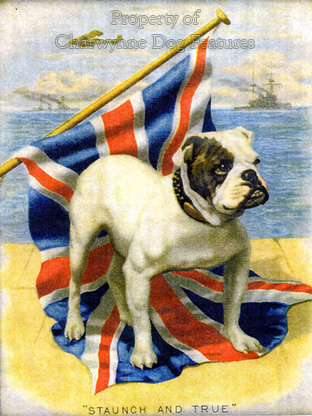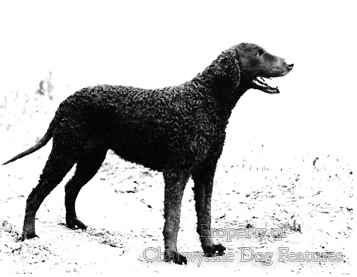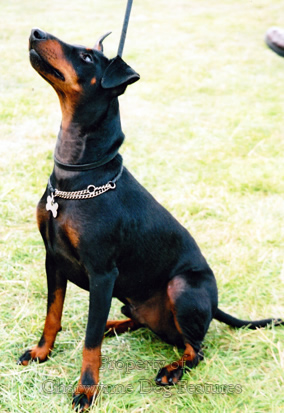5 CONSERVING OUR BRITISH BREEDS
CONSERVING OUR BRITISH BREEDS - The Future of the British Dog
by David Hancock
 Fluctuating Fortunes
Fluctuating Fortunes
A glance at the registrations of hounds with the KC reveals the fluctuating fortunes of most breeds. In 1908, scenthound breed registrations were: Basset Hounds 15; Beagles 4; Bloodhounds 113; Elkhounds 5, with no KC registrations of Otterhounds, Harriers (recognized then) and Foxhounds. No other scenthound breeds were recognized then. A century later (2010), the scene is very different for these breeds: Basset Hounds 1003 (up from 25 in 1950); Beagles 2877 (up from 64 in 1950); Bloodhounds 55 (up from 39 in 1950); Norwegian Elkhounds 33 (down from 300 in 1950); Otterhounds 57 (up from zero in 1950), with no registrations of Harriers (still unrecognized, or Foxhounds, despite being recognized). But in 2010, 1,243 Rhodesian Ridgebacks, after only 56 in 1954, 318 in 1980 and 643 in 1992, were registered; a remarkable increase. Yet in Hamiltonstovares, after 31 in 1999, only 6 were registered in 2010. Bassets Fauve de Bretagne went from 40 a year in the 1990s to 117 in 2010. Into the lists came Bavarian Mountain Hounds with 73 in 2010. It is difficult to make rational conclusions from such fluctuations beyond human whim, combined with our fondness for novelty. The success of the Rhodesian Ridgeback as a breed is well deserved – there is responsible breed stewardship here and impressive hounds in the ring; in a previous chapter I set out its evolution, which, like that of the Dogo Argentino, is, unusually in hound breeds, a matter of recorded history. We are denied the latter breed by the ill-conceived Dangerous Dogs Act, but the African hound has truly and deservedly made its mark here.
Buy British!
But why favour a scenthound from Sweden, like the Hamiltonstovare, when we have superlative and very similar hounds here like the Studbook and West Country Harriers? Why import a Grand Griffon Vendeen when we have the highly rated Welsh Hound available, of comparable type? Why, if you fancy the Basset Hound, not go for the delightful little scent hounds developed as the English or Hunting Basset? What are the advantages of the Grand Bleu de Gascogne over our steadfast and long-proven Staghound? And have those now bringing in the Segugio Italiano ever seen a Trail Hound in Cumbria, they really are something special. They race rather than hunt, they run freely rather than as a pack, but their genes are so valuable. They have Pointer blood in them; their breeders sought performance from superb hounds, not pure-blooded fading stock, losing virility, yet still bred in a closed gene pool for 'old times sake' or salient breed points unconnected with performance. We lost the famed Dumfriesshire Foxhounds and now import the similar-looking Bavarian Mountain Hound, much as I admire the latter, already committed to tracking trials that should ‘keep it honest’. 
Preserving Bloodlines
Perhaps the best way of ensuring that there is a future for our distinguished varieties of packhound is a sustained cooperation between MFHs and the breed clubs for the show hounds, rather as Beagles and the Albany Bassets were once run. It would be good to see too, from the show ring fraternity, sustained moral support for the packs, financial support for the Countryside Alliance, allied with indefatigable campaigning for the misguided Hunting Act to be removed from the statute book. Those who breed hounds need an incentive. Those who breed superlative hounds anywhere need motivation. Perhaps, a revival of hunting-hound trials, held in the early days of Foxhunting would be of value. In 1829 for example, 600 riders watched seven couples from local packs in the north Midlands compete against each other in a match. At a subsequent contest in Yorkshire, 18 couples competed, with each hound able to score up to ten points, with marks deducted for babbling, rioting, overshooting the hunted line, etc. We shouldn’t leave it to the French to perpetuate such hunting field fun. Let’s keep the activities going. Let's keep the bloodlines going - and the campaigning. For all scenthound pet owners too, I have a plea: afford them spiritual release, give then nose-work, let them go tracking, provide them with sensory stimulation. These dogs were specifically developed over centuries to exercise their incredible powers of scenting; respect their instinctive needs and see the happier hound you have empowered.
Britain’s Terriers
For a nation which has given the world a score of distinguished sporting terrier breeds, many of them preferred to the overseas native breeds on sheer merit, we must now work to ensure that all the dedicated work of our forefathers is not thrown away. In this book I have campaigned for terriers which are fit for their time-honoured function; if we do not respect their origins we will destroy many long-established much-admired terrier breeds, not just by neglect or indifference but from being arrogant enough to attempt their redesign on false criteria. Terriers do not need ground-hugging coats, heads like boot-boxes or a front assembly which denies them forward reach. Their locomotion should not be so impaired that they end up moving like canine millipedes. They should not ‘carry a leg’, as so many Jack Russells do, because of knee problems. The Bull Terrier does not deserve to be the only breed of dog with a rugger-ball for a head. This was very much a 20th century infliction, never a breed feature before that. The Staffordshire Bull Terrier does not deserve to be proscribed in countries abroad because of confusion between its famed tenacity and the misuse of this by man. The Dandie Dinmont’s topknot should not be more valued than a functional anatomy. The Fox Terrier deserves to be put back to work. The terrier breeds are very much Britain’s contribution to the canine world and we have much to do to restore most of them to their true form. Here’s to a long life for our revered breeds of terrier; they deserve all the affection and care we can muster.
Overseas Registrations
In 1998, the Kennel Club newly registered over 1,400 German short-haired pointers against under 700 of our own; nearly 500 American Cocker Spaniels against 58 Sussex Spaniels and more Brittanys than either Field or Clumber Spaniels. Shakespeare may have written that our mastiffs 'are of unmatchable courage' but the public prefer a German mastiff, the Great Dane, with over 2,000 of the latter registered each year, against less than 500 of our native breed. In the light of this, you could be forgiven for thinking that we are doing a great deal to perpetuate foreign breeds and very little to conserve our own native breeds. There is a serious threat to a number of our renowned British breeds which could lead to their disappearance within thirty years.
Even fifty years ago, the shooting men went for British gundogs; not any more. Each year an additional three and a half thousand pointers from Germany increase the German representation, to outnumber the combined annual registrations of all the setter breeds and the pointer of these islands. More Italian spinones and Hungarian vizslas are registered annually than four of our spaniel breeds. The preference for 'hunt, point and retrieve' breeds has largely caused this, but if our ancestors had needed an allrounder, they would have bred one themselves -- and it would have been a world-beater. Have our sportsmen lost their breeding skills as well as their patriotism? The Kennel Club may claim that they have never lost a native breed from their lists but that is not due to their patriotic interest but the devotion of committed fanciers.
The Kennel Club recognises over 50 breeds in their Working and Pastoral Group; 42 of them originated overseas. Of the 23 breeds in the Toy Group, 19 of them came from abroad. 24 of the 25 breeds in the Utility Group came to us from overseas. 26 of the 33 breeds in the Hound Group came from outside the United Kingdom. Every year more breeds come on to the register, some of them from strange backgrounds. The pretentiously named Pharoah hound is actually a rabbit dog from Gozo; nearly 300 have been registered in the last ten years. Foreign breeders rarely let their best stock go; without long breeding records, who knows what 'genetic junk' we are introducing?
Against that background it is disturbing to check the registrations of those of our native breeds, with extremely long breeding records, with fewer than 200 being bred each year: the Curly-coated Retriever; Clumber, Field, Irish Water and Sussex Spaniels; Dandie Dinmont, Manchester, Norwich, Sealyham, Skye, English Toy (black and Tan) and Miniature Bull Terriers; Smooth Collie, Otterhound, Bloodhound and Welsh Corgi (Cardigan). Their names alone usually show how British they are. Compare under 200 a year of each of them with the 21,000 German Shepherd Dogs, 9,500 German Boxers and nearly 5,000 Rottweilers newly registered each year.
As the Sealyham Terrier fades (182 registered in 1989, only 48 in 1998) and the Dandie Dinmont Terrier declines (256 in 1988, only 167 in 1998), we are importing the Cesky Terrier, developed overseas from the Sealyham. As the Field Spaniel struggles to gain new owners (122 in 1989, against 72 in 1998), the Hungarian Vizsla goes from 223 in 1990 to 528 in 1998. We lost our English Water Spaniel but now import both the Portuguese and the Spanish Water Dogs. As the Smooth Collie goes from 148 registrations in 1989 to 48 in 1998, we import six times that number of Australian Shepherds, 315 in 1994. Seven times as many Siberian Huskies were registered here in 1998 than Skye Terriers. In such a way did we lose the English White Terrier, an elegant charming dog and a long established breed type.
In Japan, Portugal and Denmark they have national societies to protect and conserve their native breeds of dog. The Broholm mastiff in Denmark is not available for export because every dog in the breed is valued. There is no such national society in Britain. Through the National Trust and English Heritage we are safeguarding our famous buildings and historic sites. Through the admirable Rare Breeds Survival Trust we are commendably striving to conserve our Tamworth and Gloucester Old Spot pigs, Bagot goats, Shropshire sheep, Longhorn cattle and native breeds of poultry, but who is going to protect our precious breeds of native dog as indifference and exotic preferences ensure their demise? They too are part of our heritage.
Fortunately there are some artisan breeders already at work restoring the Bedlington and Sealyham Terriers to their working design, resurrecting the very attractive Sporting Lucas Terrier and promoting the Patterdale. The country sports writer Brian Plummer, blending skill, knowledge, vision and enterprise, has developed his own breed of terrier, named after him and predictably well respected by those who work their dogs. But where are the landed gentry in such work? Where are the successors to the likes of the Duke of Gordon and his setters, the Duke of Newcastle and his Clumbers, the Earls of Southesk and Carlisle and Lord Ossulton and their setters, Lord Orford and his greyhounds, Lord Tweedmouth and his golden retrievers and Lord Knutsford and his Labradors?
Without leadership, either from a traditional source or from the Kennel Club, which sees no role for itself in conserving historic British breeds, how can we put this right? We probably need, first of all, a new kind of Kennel Club dedicated to the remaining British sporting breeds and their survival. Is this something for the BFSS to foster? The American Kennel Club does not have the monopoly which ours exploits, indeed one of the AKC's rival organisations, the United Kennel Club, registers more dogs annually than our KC and licences most of the working activities there. An enterprising and enlightened dog food manufacturer would find good rewards from the sponsorship of such a worthy organisation as a new more patriotic Sporting Kennel Club in Britain.
Secondly there is a need to restrict the entirely capricious and wholly unjustified importation of fresh foreign breeds into this country. Coming along behind the German short-haired Pointers are the Stichelhaars and the Langhaars, behind the Large Munsterlander is the small variety and then there are the French pointers: the Braque D'Auvergne, the Braque St.Germain and the two sizes of Braque Francais, and the Epagneuls: Picard, de Pont-Audemer and Francais, as well as the Dutch dogs: the Stabyhoun and the Drentse Patrijshond - we could be overwhelmed! 
The Federation Cynologique Internationale (FCI) or world kennel club, recognises 340 breeds, well over twice the number recognised by our KC and the American KC. But the FCI has at last acknowledged the need to restrict the number of new breeds it accepts. It now demands a minimum of eight distinct bloodlines, at least a thousand dogs registered and evidence of control of hereditary problems. Against those criteria, breeds like the Chinese Shar Pei would never be allowed in here.
Thirdly there is a need to counter the ignorance of old British breeds. Why import a Stumpytail Cattle Dog from Australia when the lookalike bob-tailed sheepdogs of the Black Mountain on the Herefordshire border are being neglected? Why import the Petit Brabancon (the smooth toy griffon) when our comparable Toy Black and Tan Terrier is losing ground? Why import a Hamiltonstovare from Sweden when our similar stud-book Harrier is so handsome and well bred? We lose our sedge-coloured Norfolk Retriever and then import a sedge-coloured retriever, the Chesapeake Bay, from Norfolk, Virginia. We lose our red decoy-dog and then import a red Nova Scotia Duck-Tolling Retriever with an identical role.
For a nation accused of living in the past, we are paradoxically fast losing our living heritage. In thirty years time, when Britain is aghast at the incidence of inherited diseases in pedigree dogs, the loss of genetically-healthy age-old proven breeds of our native dogs will really be felt, and we only have ourselves to blame. Step forward patriotic country sportsmen, give some thought to the next millennium. Will not one of you re-create the English White Terrier, the Shropshire Black and Tan, the Cheshire White or the real Yorkie? If you haven't the resources for that, do what you can for the Sealyham, the Dandie Dinmont, the Skye and the Manchester Terriers, the latter only registering around 100 pups a year these days. Only 58 Sussex Spaniels were registered in 1998, a lovely old breed fading away. Buy British dogs - before it's too late!